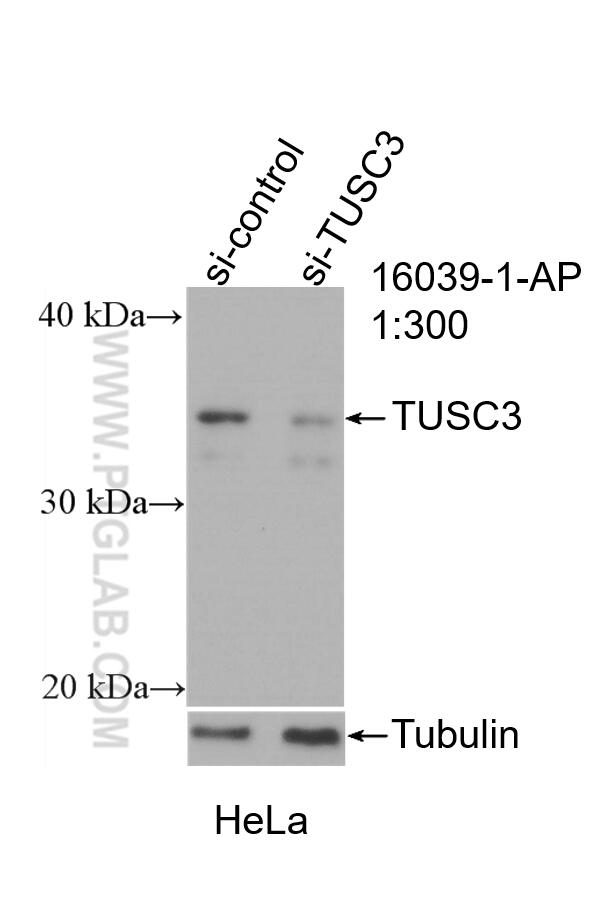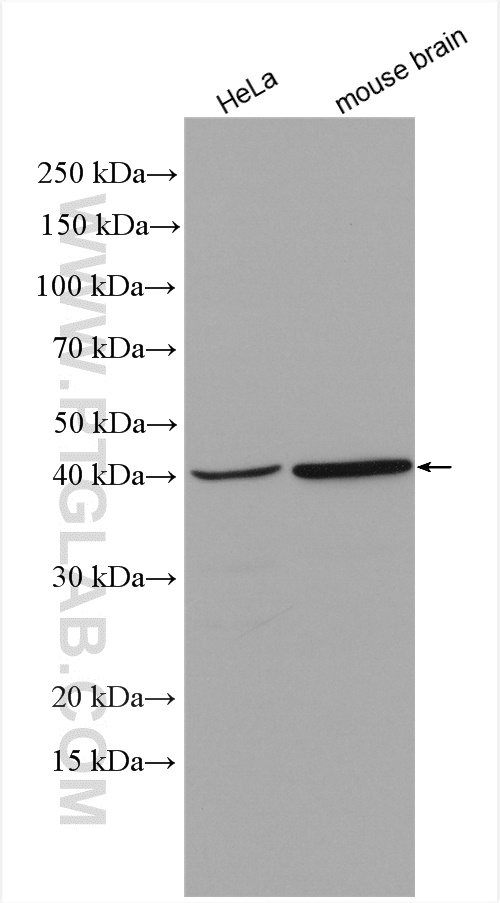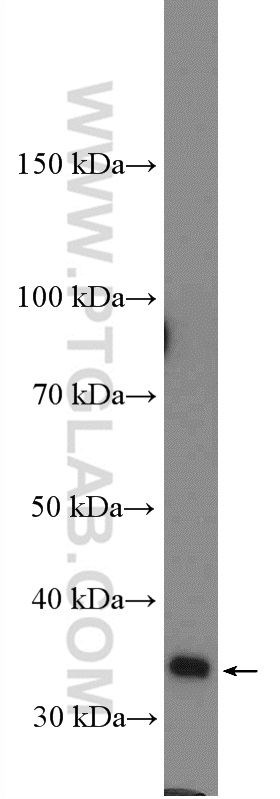验证数据展示
经过测试的应用
| Positive WB detected in | HeLa cells, rat testis tissue, mouse brain tissue |
推荐稀释比
| 应用 | 推荐稀释比 |
|---|---|
| Western Blot (WB) | WB : 1:500-1:3000 |
| It is recommended that this reagent should be titrated in each testing system to obtain optimal results. | |
| Sample-dependent, Check data in validation data gallery. | |
发表文章中的应用
| KD/KO | See 3 publications below |
| WB | See 5 publications below |
| IHC | See 2 publications below |
产品信息
16039-1-AP targets TUSC3 in WB, IHC, ELISA applications and shows reactivity with human, mouse, rat samples.
| 经测试应用 | WB, ELISA Application Description |
| 文献引用应用 | WB, IHC |
| 经测试反应性 | human, mouse, rat |
| 文献引用反应性 | human |
| 免疫原 | TUSC3 fusion protein Ag8912 种属同源性预测 |
| 宿主/亚型 | Rabbit / IgG |
| 抗体类别 | Polyclonal |
| 产品类型 | Antibody |
| 全称 | tumor suppressor candidate 3 |
| 别名 | M33, MRT7, N33, OST3A, Protein N33, tumor suppressor candidate 3, TUSC3 |
| 计算分子量 | 347 aa, 40 kDa |
| 观测分子量 | 35-40 kDa |
| GenBank蛋白编号 | BC010370 |
| 基因名称 | TUSC3 |
| Gene ID (NCBI) | 7991 |
| RRID | AB_2878208 |
| 偶联类型 | Unconjugated |
| 形式 | Liquid |
| 纯化方式 | Antigen affinity purification |
| UNIPROT ID | Q13454 |
| 储存缓冲液 | PBS with 0.02% sodium azide and 50% glycerol , pH 7.3 |
| 储存条件 | Store at -20°C. Stable for one year after shipment. Aliquoting is unnecessary for -20oC storage. |
背景介绍
TUSC3 (tumor suppressor candidate 3), originally named N33, is a potential tumor supressor gene. Decreased expression of TUSC3 has been found in various cancers, including prostate cancer, pancreas cancer and ovary cancer. TUSC3 also known as OST3A, is identified as a part of the oligosaccharyl-transferase (OST) complex and plays a crucial role in protein N-glycosylation. TUSC3 mutations have been found in families with non-syndromic autosomal recessive mental retardation.
实验方案
| Product Specific Protocols | |
|---|---|
| WB protocol for TUSC3 antibody 16039-1-AP | Download protocol |
| Standard Protocols | |
|---|---|
| Click here to view our Standard Protocols |
发表文章
| Species | Application | Title |
|---|---|---|
Nat Commun miRNA-mediated TUSC3 deficiency enhances UPR and ERAD to promote metastatic potential of NSCLC. | ||
J Cell Biol Oxidoreductase activity is necessary for N-glycosylation of cysteine-proximal acceptor sites in glycoproteins.
| ||
Sci Rep Mammalian cells lacking either the cotranslational or posttranslocational oligosaccharyltransferase complex display substrate-dependent defects in asparagine linked glycosylation.
| ||
J Biol Chem ER entry pathway and glycosylation of GPI-anchored proteins are determined by N-terminal signal sequence and C-terminal GPI-attachment sequence | ||
J Transl Med Downregulation of TUSC3 promotes EMT and hepatocellular carcinoma progression through LIPC/AKT axis
| ||
J Allergy Clin Immunol Epigenetic activation of the TUSC3 gene as a potential therapy for XMEN disease |


